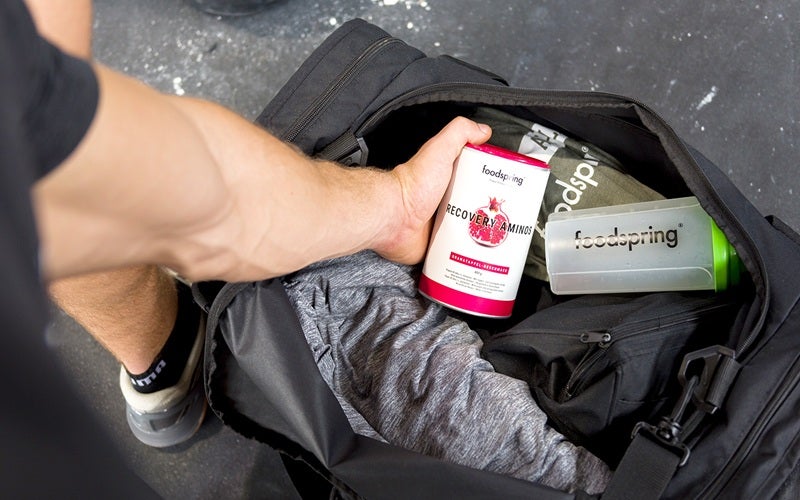Basic endurance – how do you keep the pace for longer?
 ©svetkid
©svetkid
Running, cycling, swimming, playing. With strong basic endurance, you can keep doing what you love longer (and faster!). Let’s explain how you can work on your endurance.
Contents
- What is basic endurance?
- Why do you need basic endurance?
- How to train for endurance
- Other kinds of endurance
- Summary
What is basic endurance?
Basic endurance refers to the ability to maintain a steady performance at a comfortable pace over a longer period of time, like, let’s say, running for 40 minutes. Basic endurance is the basis of your training and is a regular part of every training plan. You can build up your basic endurance by running relatively slowly and for a little longer each time.
The simplest way to train your basic endurance is to have a concrete goal in mind – it’s an integral part of every good half marathon training plan, for example!
Tip: Running on an empty stomach burns fat, but not that efficiently, since you’ll burn fewer calories overall than if you train more intensively. But if you want to scorch those calories and give it your all during training, you should do so. Our Energy Bar is the perfect snack for you to enjoy, ideally 30-45 minutes before training.

Support your endurance training
There are two types of basic endurance. The first (GA1) is about being able to handle being on the road for a long time. The target duration is 45 minutes to 3 hours (depending on your level and goal) running very slowly, at a leisurely pace – this is perfect for running in pairs and chatting! If you’re training using a heart rate, it should be between 60% and 70% of your maximum.
The second basic endurance range (GA2) is achieved at a higher but still moderate speed for a longer period of time, about 35 – 60 minutes. Your heart rate should be between 75 – 85%. You are still able to talk, but it will be a little trickier to keep up a conversation. These workouts are slightly shorter than your GA1 sessions.
Why do you need basic endurance?
Basic endurance training is the basis of any endurance training. It is also beneficial for footballers, handballers and functional athletes. You’ll only be able to tackle longer challenges such as (half) marathons or triathlons if you have a good basic endurance level, and you’ll recover more easily from sprints.
In addition to improving your performance, you should also train your basic endurance for the sake of your general health. Basic endurance training in the GA1 range increases the tolerance of your passive locomotor system. This is especially important as a runner: while muscles learn quickly, ligaments, tendons, and bones need much more time to get used to the new strain and to withstand it. If you overdo it, you risk overuse injuries.
Basic endurance training in the GA1 range gets you mentally and physically used to being on your feet for a long time while achieving a constant level of performance. Incidentally, this is also the type of exercise that affects your fat metabolism and keeps your cardiovascular system fit.
Tip: Before your workout, have a drink that helps you go the extra mile. BCAAs, caffeine and pepper give you the ultimate energy kick you need before your next run. No artificial flavors added, just extra power. Works best when drunk 20 minutes before your workout starts.
The GA 2 basic training zone is slightly faster and shorter. These sessions improve your endurance and speed, and are optimal preparation for a half marathon. You’ll be learning to keep a faster but still relaxed tempo over longer distances.
Guidelines for endurance training
The best way to train your basic endurance is a combination of extensive and intensive continuous and interval training. It may sound complicated but it’s actually simple, varied and super effective. Each training method should be on your training schedule once a week. How long you train exactly depends on your level of experience in the respective sport and of course on the sport itself. As a triathlete, runner, ultra runner or footballer you should put together a training plan that fits your individual needs and your level of performance.
Having a hard time figuring out how to get started? We can help with our workout plans. Have a look and see which one is right for you.

Extensive continuous method
This is your chatty, social run. Here, you’re running at a comfortable pace for a long time, so you can gab, talk on the phone or maybe even hold meetings. It’s ideal for socializing.
Intensive continuous method
This is a faster tempo, but in such a way that you can still have a conversation when needed.
Interval training
What exactly your interval training looks like depends on your goal and your sport. The basic principle, however, is always the same. A (relatively) short high-intensity training session is followed by a break in which you recover enough to be able to endure another high-intensity phase.
By the way: Interval training not only improves your basic endurance, but also your speed. Thanks to its afterburn, you also burn a lot of calories. That makes it a great choice for losing weight.
2 basic types of endurance and other forms of endurance
There are several types of endurance. Our table lays out an overview.
All forms are related and all have their foundation in a solid basic endurance level, which should always be the foundation of your training.
| Training type | Talking mood % max heart rate | Qualities |
|---|---|---|
| Basic endurance 1 | Chatty 65-75 |
|
| Basic endurance 2 | Slightly less talkative 75-85 |
|
| Race-specific endurance | Breathing hard 85-95 |
|
| Recovery | Time to celebrate 55-60 |
|
Apart from these forms, which are important in your basic endurance training, the types of endurance are broken down by how long you can sustain a burst. Basic endurance training always falls under long term endurance range 2 or – for very trained athletes – long term endurance range 3 or 4.
Short-term endurance: 30 seconds – 2 minutes
- Medium endurance: 3 minutes – 10 minutes
- Long term endurance 1: 11 minutes – 35 minutes
- Long term endurance 2: 36 minutes – 90 minutes
- Long term endurance 3: 91 minutes – 6 hours
- Long term endurance 4: from 6 hours
Moreover, there’s also strength endurance and speed endurance. Strength endurance is about exerting a certain amount of power over a longer period of time. Speed endurance is about training the maximum number of fast movements that you repeat frequently.
When you’re in the thick of the intensive training phases, it can be hard to catch your breath. Your muscles need an extra serving of support to keep powering through. BCAAs and quickly available carbs get the job done after your next workout.
Summary
- Basic endurance is important for all athletes.
- Basic endurance is the basis of every endurance sport.
- It’s grouped into GA1 and GA2.
- The best way to develop your basic endurance is to have both long, low-intensity workouts and faster, shorter sessions with occasional interval training.
- Your basic endurance training plan will depend on the type of activity you do.
Sources for this article
We at foodspring use only high-quality sources, including peer-reviewed studies, to support the facts within our articles. Read our editorial policy to learn more about how we fact-check and keep our content accurate, reliable, and trustworthy.































